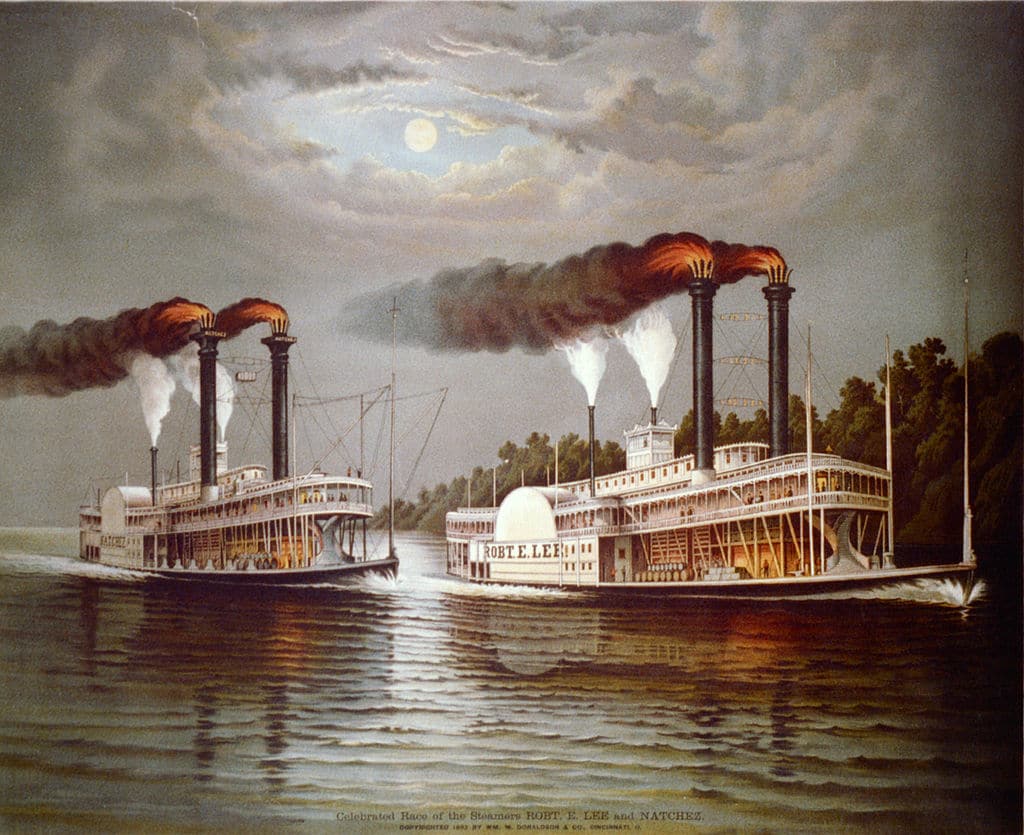
The race between the famous riverboats Robert E. Lee and Natchez was concluded on this date when the Robert E. Lee pulled into St. Louis about seven hours ahead of the Natchez.
The legendary steamboat race between the Robert E. Lee and the Natchez in 1870 remains one of the most celebrated events in the history of American river transport. This epic contest began on June 30, 1870, when the Robert E. Lee, under the command of Captain John W. Cannon, challenged the Natchez, helmed by Captain Thomas P. Leathers, to a race from New Orleans to St. Louis.
The Robert E. Lee and the Natchez were both renowned for their speed and elegance. The Robert E. Lee, a newer and more technologically advanced vessel, boasted powerful engines and a sleek design. In contrast, the Natchez, although slightly older, was known for its reliability and impressive performance on the river. At the time the race began, the Natchez held the speed record for the run from New Orleans to St. Louis. As the race commenced, large crowds gathered along the riverbanks to witness the spectacle, while newspapers across the country reported on the progress of the two steamboats.
The race was marked by intense rivalry and dramatic moments. Captain Cannon, determined to win, employed various strategies to gain an advantage, including reducing the weight of his boat by offloading non-essential items and taking on less fuel to lighten the load. Additionally, the Robert E. Lee received coal and other supplies from pre-arranged points along the river, minimizing downtime. In fact, according to newspaper reports from the time, the Robert E. Lee also carried an intentionally reduced passenger load in order to reduce weight, whereas the Natchez sailed with her normal cargo and passengers.
After an exhilarating journey that captured the nation’s imagination, the Robert E. Lee reached St. Louis on July 4, 1870, completing the race in just over three days, a record time. The Natchez arrived several hours later, delayed partly by a brief stop due to fog. Although the Robert E. Lee was declared the winner, both steamboats achieved legendary status, symbolizing the golden age of steamboat travel on the Mississippi River. Although remembered as a fierce and legendary competition in retrospect, some firsthand accounts from the time dispute this notion. According to the second engineer aboard Natchez during the race (as cited by Frederick Way Jr. in his book She Takes the Horns: Steamboat Racing on Western Waters), “This old idea about the two boats preparing for days for the race, tearing down bulkheads, putting up wind sheaves, and a lot of other stuff, is not true. When I went aboard Robert E. Lee, all they had done was to move the coal bunkers a little forward… On our boat there was absolutely no preparation whatever. There was no such thing as colors flying, bands playing, and the decks of both boats crowded with ladies and gentlemen.”
Related Posts
April 29, 1870
A new ordinance declared that dancing was prohibited in the Jefferson County Courtroom.
March 26, 1870
On this day, Lemma Barkaloo was admitted to the Missouri Bar and became the first woman to practice law in the state. However, she died a few months later from of typhoid fever.
November 14, 1870
Mayor Nathan Cole predicted a period of rapid growth for St. Louis. He said "The smoke will roll heavenward from her furnaces, mills, machine shops and factories and shall cover like a silver sheen her hills and valleys far and near." The ecology movement wasn't in full swing yet.



